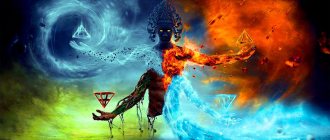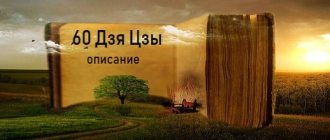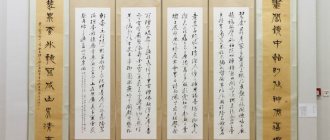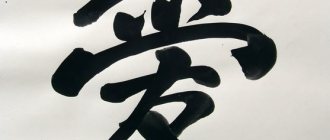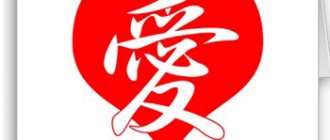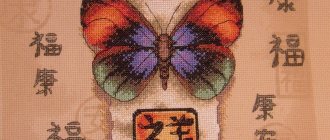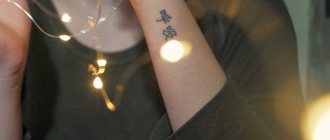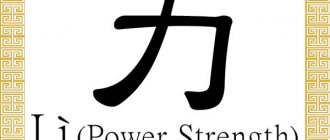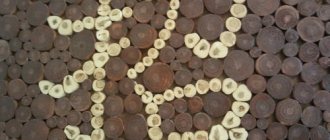The Chinese characters water, fire, earth, air, river, mountain, fish, as well as about 200 other simple characters that have come down to us from ancient times, go back in their history to the first fortune-telling pictograms used in the 18th-17th centuries BC era. Most often, such hieroglyphs are a simplified schematic representation of the object or phenomenon in question . Of course, over the centuries of their existence, the appearance of these symbols has gradually changed, but even in today’s simple hieroglyphs one can easily discern the images and meanings that the ancient Chinese put into them.
Cang Jie, the court historiographer of the legendary Yellow Emperor Huang Di, is recognized as the inventor of hieroglyphic writing in the Chinese tradition. Legend has it that he created the first simple wen 文 signs by observing the outlines of seas and mountains, the tracks of snakes and dragons, animals and birds, and the shadows cast by objects.
The first Chinese characters were signs for fortune telling, and later they were widely used in various philosophical teachings, mystical rituals and practices, such as Feng Shui. For example, three of the seven hieroglyphs considered today are among the five primary elements, which, according to Taoist beliefs, underlie any object or phenomenon of this world.
In addition, simple hieroglyphs are precisely those basic keys, those semantic units from which more complex characters of Chinese writing are composed. This means that having a good understanding of the logic of such signs and having learned them, it will be much easier for you to learn Chinese, read and memorize new characters.
Chinese character water
Let's start with the hieroglyph, which is part of the five primary elements of the ancient Chinese philosophy of Wu Xing. In this system, the element “water” is associated with such concepts as humidity, coldness, depth, mystery, rebirth, and secret knowledge. This element corresponds to the color black, the season - winter and part of the world - the north, where, according to the ideas of the ancient Chinese, large deep rivers flowed. For example, the Amur River, located north of China, is called 黑龙江 (Heilongjiang) by the Chinese, which means “Black Dragon River.”
The ancient pictogram of the hieroglyph “water” most closely resembled the flow of a river with several tributaries. Gradually, the appearance of the symbol changed, and the modern hieroglyph水(shuǐ) resembles a river flow much less, and yet, it is quite possible to guess river waves in the features of this sign.
Today, the Chinese use the character水(shuǐ) to denote both plain water and any other liquid . The same symbol can mean a stream or any body of water. It is listed as number 85 in the Chinese Character Key Chart .
The writing scheme for this hieroglyph is quite simple:
水(shuǐ) is included in a large number of complex characters:
- 水果(shuǐ guǒ) - fruit;
- 水力(shuǐ lì) “water power” - hydropower;
- 水手(shuǐ shǒu) “water master” - sailor or sailor;
- 水晶(shuǐ jīng) - crystal or crystal;
- 水泥(shuǐ ní) “liquid mud” - cement, concrete;
- 水銀(shuǐ yín) “liquid silver” - mercury.
Landscape painting, widespread in Chinese culture, is called山水畫(shān shuǐ huà), i.e. “picture of mountains and water”, and the expression心如止水(xīn rú zhǐ shuǐ) describes the serene calm of a person who is not subject to harmful human emotions and remains dispassionate even in moments of great upheaval. Even the name of the Feng Shui practice 风水 (fēng shuǐ) literally translated from Chinese means “wind and water”.
Eternity
The shape of the hieroglyph “Eternity” resembles a stream of water. The ancient Chinese personified the river expanse with the infinity of time.
Having learned to write the hieroglyph “yun” fluently and gracefully, you can consider yourself an experienced master.
The symbol-image of a woman feeding a child gave the basis to the hieroglyph “Mom”.
The symbol means: “mother”, “nurse”, “foundation”.
Wind
Historically, the hieroglyph “Wind” is a replica of the ancient pictogram “insect”.
The sign (in combination with other symbols) can have many meanings: “to fan”, “breath”, “manner”, “way”.
Chinese character river
Another symbol close in meaning to the hieroglyph水is the hieroglyph川(chuān) - river. River floods were a real natural disaster for the ancient Chinese, but at the same time, rivers were both sources of life and the main arteries connecting a large state into a single whole. Therefore, the Chinese have a separate hieroglyph for river - a Chinese symbol of the unpredictability of river flows.
This hieroglyph is included in the key table at number 47 and is used both independently and as part of complex hieroglyphs .
In modern Chinese there is another symbol meaning river, canal, stream, and is also used as an abbreviation for the Yellow River -河(hé). Here is a diagram of how to write it:
Strength in Chinese
Each sign contains a vital resource, meaning, and a fateful role. Thick brush strokes on parchment are filled with energy that helps in all areas of life.
The prototype of the “strong” hieroglyph was the plow. Some sources interpret the dynamic image as a “powerful hand.”
The “Strength” sign depicts strength of spirit, power and determination.
In dictionaries the symbol is listed as number nineteen. Together with basic semantics, the hieroglyph implies:
- power;
- determination;
- ability;
- violence;
- zeal.
The graphic symbol serves as a talisman
Fetishes that bring happiness, prosperity, health, harmony are a completely separate world. Experts do not recommend using signs with different interpretations: such symbols can strengthen natural conditions, but they can also weaken some of them. Absolute confidence, understanding, and clear awareness of interaction with the pentagram are required. The subtlest nuances and interpretations are important.
A resident of a modern metropolis who prefers an active lifestyle, in need of vital energy, can choose the “Strength” sign as a talisman. The Chinese mystical tradition considers the “image of Strength” to be an accumulator of physical health, a stabilizer, and a character booster. Supporters of “Strength” are self-confident individuals, full of plans, ideas, and desires.
“Strength” is ideal for athletes, businessmen, financiers and people in creative fields. The magical carrier of the sign nourishes the owner, “spreads its wings,” stimulates, supports, and leads to new heights.
You need to place a “strong fetish” in an accessible place, in plain sight. The amulet functions best in feng shui locations of career growth, prosperity and success (north, southeast).
Logo "Strength" in Japanese
The generally accepted theory is that Chinese texts were brought to Japan by Buddhist monks. Japan at that time did not have its own written language and successfully assimilated the Hanzi.
Initially, Kanji and Hanzi were mirror-like: graphic symbols of the Celestial Empire were used to write the text of the Land of the Rising Sun. Today there are differences between Hanzi and Kanji: some new characters were born in Japan itself, some have changed their meaning.
The basic signs are unchanged, the same for the two Asian countries.
The Japanese character for “Strength” is absolutely identical to the Chinese one. In Japanese, the pictogram reads "chikara".
Chinese character mountain
Mountains not only occupy a large place in the Chinese landscape, but also play a huge role in the culture, philosophy and beliefs of the Celestial Empire. The Chinese are absolutely sure that by climbing mountains they not only physically, but also spiritually get closer to Heaven . In China, many mountains are considered sacred. For example, the five sacred mountains of Taoism, each of which has its own part of the world, its own primary element and color. There are sacred mountains of Buddhists, with monasteries located on them, and there are mountains that are revered by representatives of all the main religious faiths of the country.
The Chinese character山(shān) means mountain, mountain range, can also mean hill, mound or grave . This is one of the oldest pictograms that has survived to our times. Even now one can easily discern in it the outlines of three mountain peaks standing firmly on the earth’s surface.
The character mountain山in Chinese is used both independently and as part of complex characters. Here are a few words that contain this hieroglyph:
- 山峰(shān fēng) - mountain peak;
- 山僧(shān sēng) “mountain monk” - hermit;
- 爬山(pá shān) - to climb a mountain;
- 山谷(shān gǔ) - valley.
There are many idiomatic expressions in Chinese using the character山:
開門見山(kāi mén jiàn shān) - if translated literally, it means “open the door and see the mountains,” but this expression is used when they want to say that they need to speak directly, with all frankness.
山盟海誓(shān méng hǎi shì) is a statement that a promise or oath should be as unbreakable and unchangeable as mountains.
山包海容(shān bāo hǎi róng) - this is what they say about a person of such broad mind and tolerance that only a mountain or sea can accommodate them.
This is how this hieroglyph should be written correctly:
The most labor-intensive sign to make
In 2006, the Chinese Academy declared: the most complex symbol of the Celestial Empire is the “soaring dragon.”
Complex hieroglyph: "Dragon soaring."
This caused an explosion of controversy: in Chinese there is an absolute “complex” leader - the pentagram indicating the type of noodles.
This mark consists of 62 brush strokes. Noodles from Shaanxi Province.
But linguists explained that the noodle symbol does not carry deep meaning and cannot be widely practiced in the language. "Dragon Soaring" continues to lead the top of the "difficult" signs.
Chinese character air
The ancient Chinese character for air resembled layers of steam rising from a hot spring . For the ancient Chinese, this was the visible embodiment of the air element.
Today this character is one of the keys at number 89 and looks like this:气(qì) . It is used both independently and as part of complex hieroglyphs. In this case, additional elements are added at the bottom left . Its meaning is not only air, but also gas, steam . It is used in expressions defining weather and climate, and even the character and temperament of a person . Here are some examples of phrases and sentences using this character:
- 氧气(yǎng qì) - oxygen;
- 空气(kōng qì) - air (atmosphere);
- 天气(tiān qì) - weather;
- 四气(sì qì) - four seasons (can also mean four feelings: pleasure, sorrow, anger and jubilation);
- 呼吸一下新鲜空气(hūxī yīxià xīnxiān kōng qì) - take a breath of fresh air.
- 不客气(bù kè qi) - do not stand on ceremony (the Chinese equivalent of “please” or “you’re welcome”).
- Air quality has deteriorated over the past few years.
And here is a diagram of the correct spelling of the hieroglyph气(qì):
Features of Chinese characters
Hanzi is the most mysterious and amazing form of writing. Each hieroglyph has its own origin story and mystical component. Writing (drawing) a sign is strictly limited by rules and traditions; image elements are written clockwise, with large horizontal components drawn first.
Beautiful Chinese writing (calligraphy) is an art that evokes inspiration, emotional uplift, and brings internal energies into balance.
A graphic symbol written by a master is considered not only a work of art, but also a magical artifact.
Chinese character earth
In Chinese philosophy, earth is one of the five primary elements, and China itself is important in this system. The element corresponded to a yellow color associated with the yellow color of the soils of Northern China, consisting of tiny compressed sand particles brought here from the deserts of Central Asia. In addition, the Earth, as a concept or image, is included in the Feng Shui trigrams and the I-Ching hexagrams (Book of Changes), and together with the Sky it forms the main central pair of Chinese metaphysics - Yin-Yang , personifying the feminine passive principle in it.
In Chinese, the character土(tǔ) is one of the key characters that has come down to us from ancient times. Its original image resembled a hill or tubercle, but gradually transformed to its modern appearance.
This is one of the most frequently used keys in the Chinese language, which can be found at number 32 in the table of radicals . As an independent symbol, it has the meaning “earth”, “territory”, “terrain”, “soil”, “dust”, etc. But most often it is used as an integral part of complex hieroglyphs, in which it is located on the left . In this case, the remaining elements of the complex hieroglyph clarify or concretize a certain concept associated with the earth. For example:
- 土壤(tǔ rǎng) - soil;
- 粘土(nián tǔ) - clay;
- 土地(tǔ dì) - land;
- 地球(dì qiú) - planet Earth;
- 庄园(zhuāngyuán) - estate.
Chinese character fire
In the ancient Chinese worldview, fire was the personification of the south . It corresponded to the color red, the season - summer and the planet Mars. In Feng Shui philosophy, the hieroglyph of fire carries the enormous power of Yang energy and denotes power, assertiveness, the desire for superiority and dominance.
It can help raise self-esteem for an insecure person. At the same time, this symbol can lead to nervous and even physical exhaustion. Indeed, under the influence of this sign, a person takes on excessive obligations and constantly strives to do something that exceeds his capabilities.
The character fire火(huǒ), like the character earth, water and others, is one of the oldest characters in Chinese writing. It is included in the table of key characters of the Chinese language at number 86 . At first glance, this symbol looks like a man raising his hands in horror, shouting “Fire! Help!". But in fact, the Chinese thus depicted a fire with flames escaping.
The hieroglyph火(huǒ) can be used as an independent word or part of complex hieroglyphs . In this case, it is depicted as four dots under the main symbol . For example, the adjective hot热(rè).
Let's look at a few more examples of using the character火(huǒ):
- 點個火(diǎn gè huǒ) - kindle (make) a fire;
- 乞火(qǐ huǒ) - ask for fire;
- 對個火(duì gè huǒ) - used in the meaning of “to smoke”;
- 一場大火(yīchǎng dàhuǒ) - big fire;
- 救火(jiùhuǒ) - put out the fire;
- 火山(huǒshān) - volcano.
In addition, this hieroglyph is used in terms related to firearms, medicine and many other concepts, including the mood and moral state of a person. For example:
- 駡他們滾開(Mà tāmen gǔn kāi) - He scolded them and kicked them out;
- 不掛火(bù guà huǒ) - to be calm, to control oneself (literally “no fire”).
Scheme of the correct sequence of writing the character火(huǒ):
Chinese character fish
For the ancient Chinese, who settled along the banks of rivers, fish, along with rice, was one of the main foodstuffs . In Chinese culture, fish has long been considered a symbol of abundance and prosperity . It is not for nothing that the hieroglyph “fish” is consonant with the hieroglyph “wealth”, only pronounced in a different tone.
, about which there are many legends, has earned special veneration in the Chinese tradition One of the most popular is the legend 李渔跳龙门 (Lǐyú tiào lóngmén) “Li Yu Tiao Longmen”. It tells how carp, with incredible determination and perseverance, went upstream to spawn, overcoming the rapids of the Yellow River. He was able to overcome all obstacles, jump over a high waterfall and, having passed through the metaphorical “Dragon Gate”, he himself turned into a Dragon and rose into the sky. Carp has become a symbol of endurance and the ability to withstand life's difficulties, persistent pursuit and goal achievement.
Therefore, it is not surprising that the appearance of the Chinese character魚(yú) goes back to the immemorial past. The original character looked like a schematic image of a fish with scales and a fiery tail, but after the reform to simplify Chinese writing, it began to look like this:鱼(yú).
Here is a diagram for writing a simplified version of the hieroglyph 鱼 (yú) fish:
This character number 195 can be found in the Chinese Character Key Chart. It is often used as a single word or as part of more complex characters. Let's look at a few words and expressions using it:
- 淺鱼(qiǎn yú) - freshwater fish;
- 海鱼(hǎi yú) - sea fish;
- 鱼者(yú zhě) - fisherman;
- 魚網(yú wǎng) - fishing net;
- 鲤鱼(ǐ yú) - carp;
- 甲鱼(jiǎ yú) - turtle;
- 鲸鱼(jīng yú) - whale;
- 鱼榼(yú kē) - a vessel for wine in the shape of a fish;
- 一條鱼可腥一鍋湯(Yītiáo yú kě xīng yī guō tāng) - literally “one fish can spoil a whole pot of soup” (a proverb close in meaning to the Russian expression “black sheep in the herd”).
At the end, we invite you to watch a funny Chinese cartoon about 36 simple Chinese characters. It is equipped with Russian subtitles and interestingly talks about the appearance of the first Chinese pictograms and their transformation into hieroglyphs.
Chinese characters water, fire, earth, air, river, mountain, fish are the most ancient and simple written characters. We'll tell you how to easily remember and use them.
